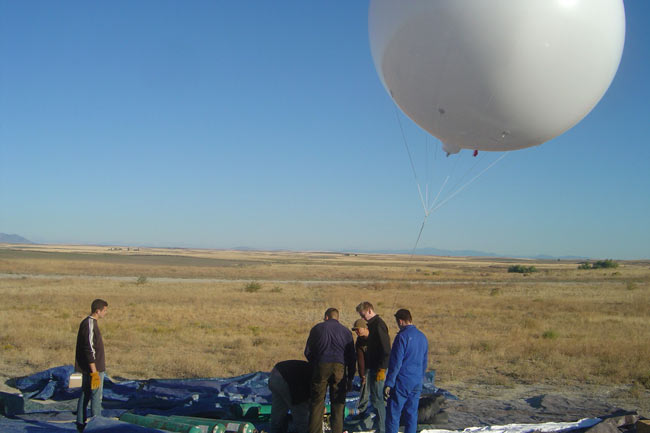Space Elevator Concept Undergoes “Reel” World Testing

Aprivate group has taken one small step toward the prospect of building afuturistic space elevator.
LiftPort Group Inc., of Bremerton, Washington, hassuccessfully tested a robot climber - a novel piece of hardware that reeleditself up and down a lengthy ribbon dangling from a high-altitude balloon.
Thetest run, conducted earlier this week, is seen as a precursor experimentintended to flight validate equipment and methods to construct a spaceelevator. This visionary concept would make use of an ultra-strong carbonnanotube composite ribbon stretching some 62,000miles (100,000 kilometers) from Earth into space.
Thespace elevator would be anchored to an offshore sea platform near the equatorin the Pacific Ocean. At the other end in space, the ribbon would be attachedto a small counterweight. Mechanical "lifters" -- robotic elevator cars --would move up and down the ribbon, carrying such items as satellites, solarpower systems, and eventually people into space.
LiftPort's plan is to take the concept from theresearch laboratory to commercial development.
Robot lifter
"Wewere very pleased with the test," said Michael Laine,President of the LiftPort Group. "It worked reallywell," he told SPACE.com.
Get the Space.com Newsletter
Breaking space news, the latest updates on rocket launches, skywatching events and more!
Theassessment of flight hardware took place September 20 at an undisclosedlocation in eastern Washington. Due to the experimental nature of theequipment, actual whereabouts of the test site can't be revealed, primarily dueto safety reasons, Laine said.
"Ifour 23-pound (10.5-kilogram) robot falls from the ribbon...we don't wantspectators to be in the way as it makes a couple thousand dollar crater," Laine explained.
Thisweek's testing involved a 12-foot (4-meter) diameter balloon. Safety lines heldby team members kept the balloon from floating away. The ribbon dangling fromthe balloon was made of composite fiberglass, with the robot lifter running upand down the tether.
"Thislifter is much smarter than our previous versions. It's our 18th version," hesaid, with the Mark VII robot named 'Sword over Damocles' or 'sword' for short.The "belt driven" robot is battery-powered, featuring two motors and anexpanded cargo area due to increased intelligence built into the device, hesaid.
Goal in sight
Duringthe day, the highest altitude reached by the balloon/ribbon/robot combinationwas 1,000 feet (305 meters). "It gives us complete confidence that the milegoal is well within reach," Laine said.
Laine said that the Federal AviationAdministration (FAA) has been very supportive and helpful in orchestratingtheir test flights.
"Weare cleared up to one mile high, off of a tethered helium balloon," Laine said. "Our series of tests are designed to gain inaltitude as we go, as we test our communications, range sensors, globalpositioning system satellite gear, along with temperature and camerasystems."
Miles to go
Furtherexperiment dates have not been pinpointed as yet, although the weather in thearea will play a key factor.
"Wehave a fairly open window to do more tests," Lainesaid. "We've probably got another month or so if we're going to do it here inWashington State."
Otheroptions are being looked at, such as staging LiftPorthardware tests from Denver, Colorado, as well as Northern California, he added.
Laine and his space elevator team know that theyhave miles to go - literally - before a space elevator can be shown to beworkable.
"Butthe test was a step in the right direction," Lainesaid. "It shows that our hardware design is valid."
LiftPort has been busy at work on the spaceelevator idea for over two years.
Furthermore,the company has created LiftPort Nanotech inMillville, New Jersey. That company is delving into mass production of nanotubes, focused on creating super-strong materials,"because, ultimately, that's what leads to a long and strong ribbon in thesky," Laine said.
"We'renot a PowerPoint company anymore...we're a hardware company," Laineconcluded.
Challenges ahead
Ina related development, the Spaceward Foundation of Mountain View, Californiahas announced the First Annual Space Elevator Competition, to be held October21 at NASA's Ames Research Center in Silicon Valley.
Twocompetitions are being held: The "Tether Challenge" and "Beam Power Challenge".These are two of the key technologies required to build a space elevator.
TheTether Challenge will test the strength and weight of carbon nanotube based materials. The Beam Power challenge willfeature climbers attempting to scale a 200-foot (61-meter) tether powered by ahigh intensity light source.
Prizemoney is furnished by the NASA Centennial Challengesprogram. Teams from universities and industry around the country have enteredinto the competitions.
- Elevator Man: Bradley Edwards Reaches for the Heights
- NASA Details Cash Prizes for Space Privatization
- Space Elevator: Momentum Building
Join our Space Forums to keep talking space on the latest missions, night sky and more! And if you have a news tip, correction or comment, let us know at: community@space.com.

Leonard David is an award-winning space journalist who has been reporting on space activities for more than 50 years. Currently writing as Space.com's Space Insider Columnist among his other projects, Leonard has authored numerous books on space exploration, Mars missions and more, with his latest being "Moon Rush: The New Space Race" published in 2019 by National Geographic. He also wrote "Mars: Our Future on the Red Planet" released in 2016 by National Geographic. Leonard has served as a correspondent for SpaceNews, Scientific American and Aerospace America for the AIAA. He has received many awards, including the first Ordway Award for Sustained Excellence in Spaceflight History in 2015 at the AAS Wernher von Braun Memorial Symposium. You can find out Leonard's latest project at his website and on Twitter.